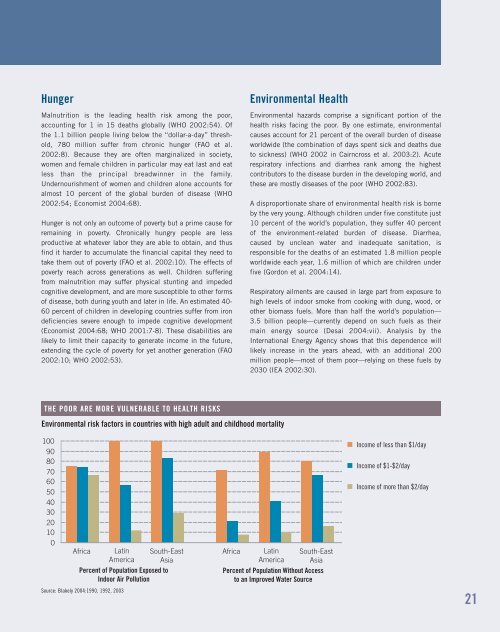jp8589 WRI.qxd - World Resources Institute
jp8589 WRI.qxd - World Resources Institute
jp8589 WRI.qxd - World Resources Institute
You also want an ePaper? Increase the reach of your titles
YUMPU automatically turns print PDFs into web optimized ePapers that Google loves.
Hunger<br />
Malnutrition is the leading health risk among the poor,<br />
accounting for 1 in 15 deaths globally (WHO 2002:54). Of<br />
the 1.1 billion people living below the “dollar-a-day” threshold,<br />
780 million suffer from chronic hunger (FAO et al.<br />
2002:8). Because they are often marginalized in society,<br />
women and female children in particular may eat last and eat<br />
less than the principal breadwinner in the family.<br />
Undernourishment of women and children alone accounts for<br />
almost 10 percent of the global burden of disease (WHO<br />
2002:54; Economist 2004:68).<br />
Hunger is not only an outcome of poverty but a prime cause for<br />
remaining in poverty. Chronically hungry people are less<br />
productive at whatever labor they are able to obtain, and thus<br />
find it harder to accumulate the financial capital they need to<br />
take them out of poverty (FAO et al. 2002:10). The effects of<br />
poverty reach across generations as well. Children suffering<br />
from malnutrition may suffer physical stunting and impeded<br />
cognitive development, and are more susceptible to other forms<br />
of disease, both during youth and later in life. An estimated 40-<br />
60 percent of children in developing countries suffer from iron<br />
deficiencies severe enough to impede cognitive development<br />
(Economist 2004:68; WHO 2001:7-8). These disabilities are<br />
likely to limit their capacity to generate income in the future,<br />
extending the cycle of poverty for yet another generation (FAO<br />
2002:10; WHO 2002:53).<br />
Environmental Health<br />
Environmental hazards comprise a significant portion of the<br />
health risks facing the poor. By one estimate, environmental<br />
causes account for 21 percent of the overall burden of disease<br />
worldwide (the combination of days spent sick and deaths due<br />
to sickness) (WHO 2002 in Cairncross et al. 2003:2). Acute<br />
respiratory infections and diarrhea rank among the highest<br />
contributors to the disease burden in the developing world, and<br />
these are mostly diseases of the poor (WHO 2002:83).<br />
A disproportionate share of environmental health risk is borne<br />
by the very young. Although children under five constitute just<br />
10 percent of the world’s population, they suffer 40 percent<br />
of the environment-related burden of disease. Diarrhea,<br />
caused by unclean water and inadequate sanitation, is<br />
responsible for the deaths of an estimated 1.8 million people<br />
worldwide each year, 1.6 million of which are children under<br />
five (Gordon et al. 2004:14).<br />
Respiratory ailments are caused in large part from exposure to<br />
high levels of indoor smoke from cooking with dung, wood, or<br />
other biomass fuels. More than half the world’s population—<br />
3.5 billion people—currently depend on such fuels as their<br />
main energy source (Desai 2004:vii). Analysis by the<br />
International Energy Agency shows that this dependence will<br />
likely increase in the years ahead, with an additional 200<br />
million people—most of them poor—relying on these fuels by<br />
2030 (IEA 2002:30).<br />
THE POOR ARE MORE VULNERABLE TO HEALTH RISKS<br />
Environmental risk factors in countries with high adult and childhood mortality<br />
100<br />
90<br />
80<br />
70<br />
60<br />
50<br />
40<br />
30<br />
20<br />
10<br />
0<br />
Africa Latin<br />
America<br />
South-East<br />
Asia<br />
Percent of Population Exposed to<br />
Indoor Air Pollution<br />
Africa<br />
Latin<br />
America<br />
South-East<br />
Asia<br />
Percent of Population Without Access<br />
to an Improved Water Source<br />
Income of less than $1/day<br />
Income of $1-$2/day<br />
Income of more than $2/day<br />
Source: Blakely 2004:1990, 1992, 2003<br />
21

















